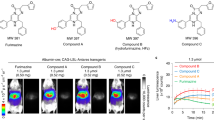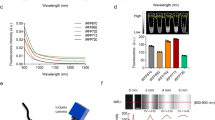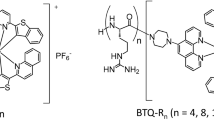Abstract
Noninvasive optical bioluminescence imaging systems are important tools for evaluating gene expression in vivo for study of individual and temporal variation in a living animal. In this report, we demonstrate that expression of the firefly luciferase reporter gene (fl) delivered by transferrin (Tf) targeted polyethylenimine (PEI) complexes with, or without, poly(ethylene glycol) (PEG) modifications can be imaged in living A/J mice bearing N2A tumors using a cooled charged coupled device (CCD) camera. Tf–PEI–PEG, Tf–PEI, and PEI (positive control) complexes were tail-vein injected and mice were imaged at 5, 24, 48, and 72 h after complex injection. After imaging, the organs were analyzed ex vivo for firefly luciferase protein (FL) activity. The Tf and PEG modified formulations show significantly (P<0.05) higher FL activity in vivo and ex vivo at the tumor as compared to other organs, including the lungs (a site of high expression with PEI, the positive control). Furthermore, the in vivo bioluminescent signal correlated well (R2=0.83) with ex vivo FL activity. These data support that noninvasive imaging of fl reporter expression can be used to monitor the specificity of Tf–PEI and Tf–PEI–PEG polyplex targeting of N2A tumors in A/J mice.
This is a preview of subscription content, access via your institution
Access options
Subscribe to this journal
Receive 12 print issues and online access
$259.00 per year
only $21.58 per issue
Buy this article
- Purchase on Springer Link
- Instant access to full article PDF
Prices may be subject to local taxes which are calculated during checkout







Similar content being viewed by others
References
Huang L, Viroonchaatapan E . Chapter 1: introduction. In: Huang L, Hung M-C, Wagner E. (eds). Nonviral Vectors for Gene Therapy. Academic Press: London, 1999, pp 4–22.
Tseng W-C, Huang L . Liposome based gene therapy. PSTT 1998; 1: 206–213.
Reddy KR . Controlled-release, pegylation, liposomal formulations: new mechanisms in the delivery of injectable drugs. Ann Pharmacother 2000; 34: 915–923.
Goula D et al. Polyethylenimine-based intravenous delivery of transgenes to mouse lung. Gene Ther 1998; 5: 1291–1295.
Boussif O et al. A versatile vector for gene and oligonucleotide transfer into cells in culture and in vivo: polyethylenimine. Proc Natl Acad Sci USA 1995; 92: 7297–7301.
Ogris M et al. PEGylated DNA/transferrin–PEI complexes: reduced interaction with blood components, extended circulation in blood and potential for systemic gene delivery. Gene Ther 1999; 6: 595–605.
Blessing T et al. Different strategies for formation of PEGylated EGF-conjugated PEI/DNA complexes for targeted gene delivery. Bioconjug Chem 2001; 12: 529–537.
Kircheis R et al. Polyethylenimine/DNA complexes shielded by transferrin target gene expression to tumors after systemic application. Gene Ther 2001; 8: 28–40.
Ray P et al. Monitoring gene therapy with reporter gene imaging. Semin Nucl Med 2001; 31: 321–320.
Contag PR, Olomu IN, Stevenson DK, Contag CH . Bioluminescent indicators in living mammals. Nat Med 1998; 4: 245–247.
Hasegawa S et al. In vivo tumor delivery of the green fluorescent protein gene to report future occurrence of metastasis. Cancer Gene Ther 2000; 7: 1336–1340.
Gambhir SS et al. Imaging transgene expression with radionuclide imaging technologies. Neoplasia 2000; 2: 118–138.
Contag CH, Jenkins D, Contag PR, Negrin RS . Use of reporter genes for optical measurements of neoplastic disease in vivo. Neoplasia 2000; 2: 41–52.
Wu JC, Sundaresan G, Iyer M, Gambhir SS . Noninvasive optical imaging of firefly luciferase reporter gene expression in skeletal muscles of living mice. Mol Ther 2001; 4: 297–306.
Honigman A et al. Imaging transgene expression in live animals. Mol Ther 2001; 4: 239–249.
Wu JC et al. Optical imaging of Q1cardiac reporter gene expression in living rats. Circulation 2002; 105(14): 1631–1634.
Ray P et al. Noninvasive quantitative imaging of protein–protein interactions in living subjects. Proc Natl Acad Sci USA 2002; 99: 3105–3110.
Iyer M, BerengiQ2 M, Templeton NS, Gambhir SS . Noninvasive imaging of cation lipid mediated delivery of optical and PET reporter genes in living mice. Mol Ther 6(4): 555–562.
Iyer M et al. Two-step transcriptional amplification as a method for imaging reporter gene expression using weak promoters. Proc Natl Acad Sci USA 2001; 98: 14595–14600.
Bhaumik S, Gambhir SS . Optical imaging of Renilla luciferase reporter gene expression in living mice. Proc Natl Acad Sci USA 2002; 99: 377–382.
Schuetz E et al. Development of a real-time in vivo transcription assay: application reveals pregnane X receptor-mediated induction of CYP3A4 by cancer chemotherapeutic agents. Mol Pharmacol 2002; 62: 439–445.
Kircheis R et al. Polycation-based DNA complexes for tumor-targeted gene delivery in vivo. J Gene Med 1999; 1: 111–120.
Kircheis R et al. Tumor targeting with surface-shielded ligand–polycation DNA complexes. J Control Release 2001; 72: 165–170.
Kircheis R et al. Coupling of cell-binding ligands to polyethylenimine for targeted gene delivery. Gene Ther 1997; 4: 409–418.
Ogris M et al. DNA/polyethylenimine transfection particles: influence of ligands, polymer size, and PEGylation on internalization and gene expression. AAPS PharmSci 2001; 3: E21.
Wagner E . Chapter 10: Ligand–polycation conjugates for receptor targeted gene transfer. In: Huang L, Hung M-C, Wagner E. (eds). Nonviral Vectors for Gene Therapy. Acedemic Press: London, 1999, pp 207–227.
Acknowledgements
We would like to thank Xiaoman Lewis and Khoi Nguyen for their technical help, David Stout for his help with the optical system, and Wolfgang Roedl and Malgorzata Kursa for providing us with formulations from Germany and Austria. This work is supported in part by National Institutes of Health Grants P50 CA86306 (SSG), R0-1 CA82214 (SSG), and SAIRP R24 CA92865 (SSG), Department of Energy Contract DE-FC03-87ER60615 (SSG).
Author information
Authors and Affiliations
Rights and permissions
About this article
Cite this article
Hildebrandt, I., Iyer, M., Wagner, E. et al. Optical imaging of transferrin targeted PEI/DNA complexes in living subjects. Gene Ther 10, 758–764 (2003). https://doi.org/10.1038/sj.gt.3301939
Received:
Accepted:
Published:
Issue Date:
DOI: https://doi.org/10.1038/sj.gt.3301939
Keywords
This article is cited by
-
Virus-mimetic polyplex particles for systemic and inflammation-specific targeted delivery of large genetic contents
Gene Therapy (2013)
-
Novel Liposomal Formulation for Targeted Gene Delivery
Pharmaceutical Research (2007)
-
Cell and Tissue Targeting of Nucleic Acids for Cancer Gene Therapy
Pharmaceutical Research (2007)
-
Evaluation of Firefly Luciferase Bioluminescence Mediated Photodynamic Toxicity in Cancer Cells
Molecular Imaging and Biology (2006)
-
Herpesvirus saimiri-based vector biodistribution using noninvasive optical imaging
Gene Therapy (2005)



